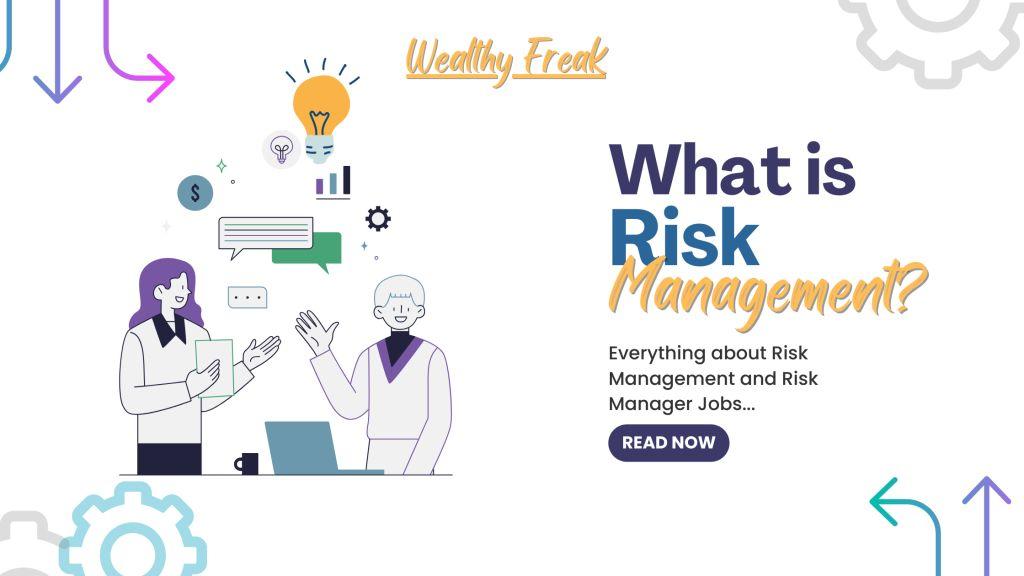Are you looking for an answer about what is Risk Management? If yes, then you are in the right place. Risk management is an essential process for any organization, regardless of size or industry. It involves identifying, assessing, and minimizing potential risks that could negatively impact an organization’s operations, finances, reputation, or people. By implementing effective risk management strategies, organizations can protect themselves from risks and capitalize on opportunities.
Understanding risk management requires a clear definition of what risk is. Risk refers to the possibility of harm or loss, and it can arise from various sources, including financial uncertainty, legal liabilities, strategic management errors, accidents, and natural disasters. Risk management is the process of identifying, assessing, and controlling these risks to an organization’s capital and earnings. It involves anticipating and understanding risks across an organization’s strategy, operations, technology, finance, and legal domains.
Key Takeaways:
- Risk management is an essential process for any organization, regardless of size or industry.
- Risk refers to the possibility of harm or loss, and risk management involves identifying, assessing, and controlling these risks to an organization’s capital and earnings.
- Effective risk management strategies can protect organizations from risks and capitalize on opportunities.
Understanding Risk Management | Risk Management Definition
Risk management is the process of identifying, assessing, and controlling potential threats to an organization’s capital, earnings, and operations. These risks can come from a variety of sources, such as financial uncertainties, legal liabilities, technology issues, strategic management errors, accidents, and natural disasters.
The goal of risk management is to minimize the negative impact of risks on the organization and maximize opportunities for growth and success. A well-implemented risk management plan can help organizations make informed decisions, reduce losses, and increase their ability to adapt to changing circumstances.
Risk management involves several steps, including:
1. Risk Identification
The first step in risk management is identifying potential risks. This can be done by reviewing past incidents, analyzing industry trends, and conducting risk assessments. It’s important to identify both internal and external risks that could impact the organization.
2. Risk Assessment
Once potential risks have been identified, the next step is to assess the likelihood and impact of each risk. This involves analyzing the probability of the risk occurring and the potential consequences if it does.
3. Risk Mitigation
After assessing the risks, the organization can then develop a plan to mitigate them. This can include implementing preventative measures, transferring the risk to another party, accepting the risk, and developing a plan to minimize the impact if it occurs.
4. Risk Monitoring and Review
Risk management is an ongoing process, and it’s important to continuously monitor and review the effectiveness of the risk management plan. This includes regularly reviewing risk assessments, updating mitigation strategies, and analyzing the impact of any incidents that do occur.
Overall, risk management is a crucial aspect of any organization’s success. By identifying potential risks and developing a plan to mitigate them, organizations can reduce losses and increase their ability to adapt to changing circumstances.
Enterprise Risk Management
Enterprise Risk Management (ERM) is a comprehensive approach to risk management that enables organizations to identify, assess, and manage risks that may impact their objectives. ERM involves a coordinated effort across all levels of an organization to identify and manage risks that may arise from various sources, including financial, operational, strategic, and compliance-related risks.
The objective of ERM is to provide a holistic view of risks facing an organization and to enable management to make informed decisions on how to manage those risks. ERM is a continuous process that involves ongoing monitoring and evaluation of risks to ensure that the organization remains resilient and can adapt to changing circumstances.
ERM frameworks typically include the following components:
- Risk identification and assessment
- Risk mitigation and control
- Risk monitoring and reporting
- Integration with strategic planning and decision-making processes
ERM frameworks can be tailored to meet the specific needs of an organization and may include additional components such as risk transfer and risk financing strategies.
One of the key benefits of ERM is that it enables organizations to take a proactive approach to risk management rather than a reactive one. By identifying and managing risks before they materialize, organizations can reduce the potential impact of those risks and minimize the likelihood of negative outcomes.
Another benefit of ERM is that it provides a common language and framework for discussing risks across an organization. This enables stakeholders at all levels to understand the risks facing the organization and to work together to manage those risks effectively.
Overall, ERM is a valuable tool for organizations looking to manage risks in a comprehensive and proactive manner. By implementing an ERM framework, organizations can improve their resilience and ability to adapt to changing circumstances and ultimately achieve their objectives with greater confidence and certainty.
5 Principles of Risk Management
Risk management is an essential aspect of operating and managing a company. In the corporate world, it’s well understood that the greater the risk, the greater the reward or return. As a result, business executives, particularly project managers, should establish risk levels and balance the lowest possible risk with the highest possible reward. Here are the five principles of risk management that will help you achieve this balance:
1. Risk Identification
The first principle of risk management is risk identification. This principle is just what it sounds like what risks are presented to you, your organization, your customers, etc., in the scenario in front of you? As an example, think about riding in or driving a car. You must identify the risks involved, such as the possibility of a car accident, before you can take steps to mitigate them.
2. Risk Analysis and Assessment
Once you have identified the risks, you must analyze and assess them. This process involves evaluating the likelihood and potential impact of each risk. You must determine the probability of the risk occurring, the severity of the impact if it does occur, and the overall risk level. This information will help you prioritize risks and determine which ones require the most attention.
3. Risk Mitigation and Monitoring
After you have identified and analyzed the risks, you must take steps to mitigate them. This process involves developing and implementing strategies to reduce the likelihood and impact of each risk. You must also monitor the risks to ensure that your mitigation strategies are effective and that new risks do not emerge.
4. Risk Communication
Risk communication is an essential part of risk management. You must communicate the risks and mitigation strategies to all stakeholders, including employees, customers, shareholders, and regulators. Effective communication will help ensure that everyone understands the risks and their role in mitigating them.
5. Risk Review and Evaluation
Finally, you must review and evaluate your risk management strategies regularly. This process involves assessing the effectiveness of your mitigation strategies, identifying new risks, and adjusting your strategies as necessary. By regularly reviewing and evaluating your risk management strategies, you can ensure that your organization is prepared to handle any potential risks that may arise.
In summary, risk management is a critical process that can help organizations protect themselves from potential losses or threats to their continued operation. By following these five principles of risk management, you can effectively identify, analyze, mitigate, communicate, and evaluate risks to achieve the optimal balance between risk and reward.
Roles in Risk Management
Risk management is a crucial aspect of any organization, and there are several roles involved in ensuring that risks are identified, assessed, and mitigated. In this section, we will discuss the different roles in risk management, including risk management jobs and risk manager jobs.
Risk Management Jobs
Risk management jobs involve identifying, assessing, and mitigating risks to an organization. These jobs require individuals who possess keen observation, analytical, and problem-solving skills. Some common risk management jobs include:
- Risk Analyst: A risk analyst is responsible for identifying and analyzing potential risks to an organization. They use data and statistical analysis to assess the likelihood and impact of risks and develop strategies to mitigate them.
- Risk Consultant: A risk consultant provides advice and guidance to organizations on risk management strategies. They work with clients to identify potential risks, assess their impact, and develop risk management plans.
- Compliance Officer: A compliance officer ensures that an organization complies with all relevant laws, regulations, and policies. They identify potential compliance risks and develop strategies to mitigate them.
Risk Manager Jobs
Somehow, Wealth Manager is the same designation but a completely different one. Risk manager jobs involve overseeing the risk management process in an organization. These jobs require individuals who possess leadership, communication, and decision-making skills. Some common risk manager jobs include:
- Enterprise Risk Manager: An enterprise risk manager is responsible for overseeing the risk management process across an entire organization. They develop risk management policies and procedures, identify potential risks, and work with other departments to implement risk management strategies.
- Operational Risk Manager: An operational risk manager is responsible for identifying and mitigating risks related to an organization’s day-to-day operations. They work with other departments to develop and implement risk management strategies that ensure the smooth operation of the organization.
- Credit Risk Manager: A credit risk manager is responsible for assessing the creditworthiness of borrowers and managing the risk of default. They develop credit risk policies and procedures, analyze credit data, and make recommendations on lending decisions.
Risk management and risk manager jobs are essential roles in any organization. They are responsible for identifying, assessing, and mitigating risks that could impact an organization’s financial, legal, strategic, and security interests. If you are interested in a career in risk management, consider pursuing a degree or certification in the field and developing the necessary skills and experience to succeed.
Conclusion
In conclusion, risk management is a critical process for any organization. It involves identifying, assessing, and controlling risks that could negatively impact the organization’s capital, earnings, and operations. By implementing a risk management program, you can protect your organization from potential losses and ensure that you are well-prepared to deal with any unexpected events.
One of the key benefits of risk management is that it helps you identify potential risks before they become actual problems. By conducting a thorough risk assessment, you can identify areas of your organization that are most vulnerable to risk and take proactive steps to mitigate those risks. This can help you avoid costly mistakes and ensure that your organization is well-positioned to succeed in the long term.
Another benefit of risk management is that it helps you prioritize your resources. By understanding which risks are most significant, you can allocate your resources more effectively and focus on the areas of your organization that are most in need of attention. This can help you to make better decisions and ensure that your organization is operating as efficiently as possible.
Overall, risk management is an essential process for any organization that wants to succeed in today’s complex business environment. By implementing a comprehensive risk management program, you can protect your organization from potential losses, identify potential risks before they become actual problems, and prioritize your resources more effectively.
FAQs
What are the 5 principles of risk management?
The five principles of risk management are: Identify the risks, Assess the risks, and Evaluate the risks. Treat the risks
Monitor and review the risks.
What is the main purpose of Risk Management?
The main purpose of risk management is to identify, assess, and manage risks that could affect an organization’s ability to achieve its objectives. By managing risks, organizations can minimize the likelihood of negative events occurring and maximize the likelihood of achieving their objectives.
What are the 3 types of risk management?
The three types of risk management are:
Strategic risk management – focuses on risks that may affect an organization’s overall strategy and objectives.
Operational risk management – focuses on risks that may affect an organization’s day-to-day operations.
Financial risk management – focuses on risks that may affect an organization’s financial performance.
What is risk management in project management?
Risk management in project management is the process of identifying, assessing, and managing risks that may affect the success of a project. By managing risks, project managers can minimize the likelihood of negative events occurring and maximize the likelihood of achieving project objectives.
What is risk management in insurance?
Risk management in insurance is the process of identifying, assessing, and managing risks that may affect an insurance company’s ability to meet its obligations to policyholders. By managing risks, insurance companies can minimize the likelihood of negative events occurring and maximize the likelihood of meeting their obligations to policyholders.
What is risk management in banking?
Risk management in banking is the process of identifying, assessing, and managing risks that may affect a bank’s ability to meet its obligations to depositors and investors. By managing risks, banks can minimize the likelihood of negative events occurring and maximize the likelihood of meeting their obligations to depositors and investors.




